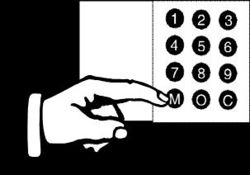Difference between revisions of "Calling and Conversation Between Stations"
From Zenitel Wiki
| Line 53: | Line 53: | ||
== Calling to/from Noicy Areas == | == Calling to/from Noicy Areas == | ||
| − | If stations are in an area with disturbing background noise, either party can manually control the speech direction by pressing the M-key while speaking, and releasing the M-key while listening (Simplex). Using the M-key also increases the volume at the listening end.<br> | + | If stations are in an area with disturbing background noise, either party can manually control the speech direction by pressing the M-key while speaking, and releasing the M-key while listening (Simplex). Using the M-key also increases the volume at the listening end. |
| + | |||
| + | To switch back to automatic direction switching (Duplex), simply press the M-key briefly. Either party can perform these actions. | ||
| + | [[image:Call in Noisy Areas.jpg|thumb|left|250px|]]<br> | ||
| + | <br> | ||
| + | <br> | ||
<br> | <br> | ||
<br> | <br> | ||
| Line 63: | Line 68: | ||
<br> | <br> | ||
<br> | <br> | ||
| − | |||
| − | |||
| − | |||
== Using the Handset For “Telephone-Like” Conversations == | == Using the Handset For “Telephone-Like” Conversations == | ||
Revision as of 12:45, 29 June 2007
Contents
Initiating and Canceling a Hands-free Call
To call another station, just dial the number of the station. If you have the number programmed on a single-touch key, just press this key. When the call is connected in open mode, a warning tone is heard and the red lamp lights on both stations.
With TouchLine stations most users appreciate this hands-free conversation. Others prefer “telephone”-like calls where the called party accepts the call (typically by lifting the handset). This is explained on the next page.
During the conversation the system automatically switches the voice direction from one station to the other depending on the voice levels at each end (Duplex). In locations with normal noise levels, you can have your hands free throughout the conversation, and you can speak from wherever you are in the room.
To end the call, either party may press the C-key. The red lamp goes out on both stations.
Additional Information
- The AlphaCom System allows you to reach the same station with several different directory numbers. This is useful if several people share the same room, and you want their names available on the Name Directory.
- The system differentiates between stations and users. Maximum number of stations in a 4-module system is 552, max. number of users is 600. Max. number of station is a Basic Module is 138.
Call Setup Priority
Each station has a priority setting which decides how outgoing calls from that station are treated at the receiving station. All stations are given medium priority in the autoload.
| Action/Priority | Low | Medium | High | Alarm |
| Call to an idle,
open station |
Rings | Connects | Connects | Connects |
| Call to station with
private switch ON |
Rings | Rings | Connects | Connects |
| Call to a station with an
absence message |
Hears the message | Hears the message | Connects | Connects |
| Call to a busy station | Busy tone | Busy tone | Busy tone | Connects |
Calling to/from Noicy Areas
If stations are in an area with disturbing background noise, either party can manually control the speech direction by pressing the M-key while speaking, and releasing the M-key while listening (Simplex). Using the M-key also increases the volume at the listening end.
To switch back to automatic direction switching (Duplex), simply press the M-key briefly. Either party can perform these actions.
Using the Handset For “Telephone-Like” Conversations
If the intercom station has a handset, you can lift the handset to speak confidentially. In this way, the station can be used just like a telephone. If you lift the handset before making a call, you will hear a dialing tone. This stops as soon as you start dialing, as for a normal telephone. It is also possible to lift the handset at any time during the conversation.
If both parties lift their handsets, both can speak simultaneously (open duplex). If only one uses the handset, the speech direction is automatically switched. You can return to hands-free conversation during the call by holding down the M-key while replacing the handset, thus avoiding canceling the call.
To end the conversation, either press the C-key, or replace the handset (this time without pressing the M-key).
Making and Recieving Calls in Private Mode
Normally, calls come straight through with a short tone. You can, however, set a "Private" mode on the station to force incoming calls to be announced by a ringing tone. To set private mode: slide the switch on the station right across from OPEN to PRIVATE.
All incoming calls will then be indicated by a ringing tone. You can accept a call by pressing the M-key or lifting the handset. If the call is not accepted, it will automatically be cut off after 30 seconds (default).
Outgoing calls remain unchanged, regardless of the position of the switch
Adiditional Information
- The default time-out for private ringing is programmable.
- Certain intercom stations, for example the switchboard operator's station, may override "Private mode automatically or by pressing M during the ringing tone.
- A station may be set so that outgoing calls are always in "Open" or "Private" mode, regardless of the switch setting of the station receiving the call.
- If your intercom station has no Open/Private switch, or if you want to disable the station’s Private/Open switch, you can switch between Private and Open by dialing directory numbers: PRIVATE: 7887 OPEN: 7886. This option must enabled per station.

